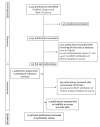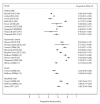A systematic review of source attribution of human campylobacteriosis using multilocus sequence typing
- PMID: 31662159
- PMCID: PMC6820127
- DOI: 10.2807/1560-7917.ES.2019.24.43.1800696
A systematic review of source attribution of human campylobacteriosis using multilocus sequence typing
Abstract
BackgroundCampylobacter is a leading global cause of bacterial gastroenteritis, motivating research to identify sources of human infection. Population genetic studies have been increasingly applied to this end, mainly using multilocus sequence typing (MLST) data.ObjectivesThis review aimed to summarise approaches and findings of these studies and identify best practice lessons for this form of genomic epidemiology.MethodsWe systematically reviewed publications using MLST data to attribute human disease isolates to source. Publications were from January 2001, when this type of approach began. Searched databases included Scopus, Web of Science and PubMed. Information on samples and isolate datasets used, as well as MLST schemes and attribution algorithms employed, was obtained. Main findings were extracted, as well as any results' validation with subsequent correction for identified biases. Meta-analysis is not reported given high levels of heterogeneity.ResultsOf 2,109 studies retrieved worldwide, 25 were included, and poultry, specifically chickens, were identified as principal source of human infection. Ruminants (cattle or sheep) were consistently implicated in a substantial proportion of cases. Data sampling and analytical approaches varied, with five different attribution algorithms used. Validation such as self-attribution of isolates from known sources was reported in five publications. No publication reported adjustment for biases identified by validation.ConclusionsCommon gaps in validation and adjustment highlight opportunities to generate improved estimates in future genomic attribution studies. The consistency of chicken as the main source of human infection, across high income countries, and despite methodological variations, highlights the public health importance of this source.
Keywords: Campylobacter; MLST; bacterial infections; epidemiology; food-borne infections; molecular methods; source attribution; surveillance.
Conflict of interest statement
Figures


References
Publication types
MeSH terms
Substances
LinkOut - more resources
Full Text Sources
Medical
